Altrincham (renamed Bucklow in 1890s) Union, Cheshire
Up to 1834
The early workhouse directory An Account of Several Workhouses... recorded that in March 1729, a workhouse had 'just now' been erected at Knutsford. In 1777, it could accommodate twenty inmates.
A workhouse existed at Rostherne from around 1739 (Hitchcock, 1985).
In 1755, the Earl of Warrington gave a 4¼-acre site site known as Broadheath on a perpetual lease of five shillings a year on which the township of Altrincham could build a workhouse. The establishment opened the following year. Following complaints about the workhouse's management, an investigation was carried out (Ingham, 1997). Its report concluded:
In 1776, the workhouse could hold fifty inmates.
In 1822, a Select Vestry was instituted at Altrincham and the following year, five looms were purchased for employing the inmates at weaving. At a meeting held on the 21st May, 1828, the overseer of the poor revealed that the governess of the workhouse had fled, "taking her clothes with her, that her husband does not know where she has gone, or whether she means to return." Helpfully, the vestry directed the overseer "to keep an eye to the workhouse" while the governor went search of his runaway spouse — if he felt so inclined. Whether he departed on this mission is not clear, but a week later it was reported that the governess has not yet returned, nor was there any probability she would. The governor was instantly discharged, and when appointing a successor it was stipulated that if the new governor and governess did not come up to expectation, they would be expected to quit the house and give up the situation in a month. They appeared to give satisfaction since soon afterwards it was "Resolved that this meeting is of opinion that the governor of the workhouse be allowed to occupy and use one of the looms in the weaving shop for the purpose of weaving in himself, and that he be allowed to take to his own the earnings therefrom, he having requested that such liberty should be allowed to him."
In 1772, the Lindow Workhouse Trust was formed to erect a workhouse to serve the Wilmslow parishes of Chorley, Fulshaw, Bollin Fee and Pownall Fee. The workhouse was located on Altrincham Road, near Green Lake, at the east of Lindow Common. In 1801, it had thirty-four occupants. After the workhouse closed in 1839, the site was leased to local farmers and the proceeds used to assist people in need in the parish of Wilmslow, something which the Lindow Trust still continues today. The former workhouse site is now occupied by Gorsey Bank School.
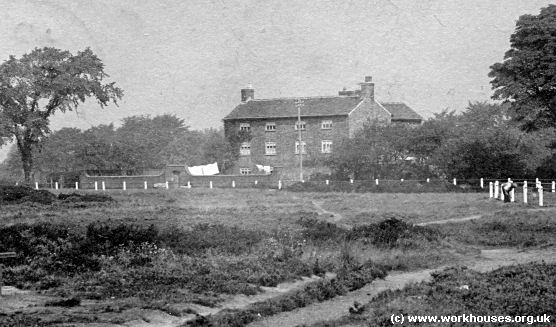
Former Pownall Fee workhouse, c.1905.
© Peter Higginbotham
In 1777, a parish workhouse holding up to thirty inmates was in use at Mobberley (30).
After 1834
Altrincham Poor Law Union officially came into existence on 25th August 1836. Its operation was overseen by an elected Board of Guardians, 45 in number, representing its 40 constituent parishes and townships as listed below (figures in brackets indicate numbers of Guardians if more than one):
County of Chester: Agden, Altrincham (2), Ashley, Ashton-upon-Mersey, Aston-by-Budworth, Baguley, Bollen Fee (2), Bollington, Bowdon, Boxton, Carrington, Dunham-Massey, Etchely, Fulshaw, Hale, Handforth-cum-Basden, High Leigh, Lymm (2), Martall with Little Warfard, Mere, Millington, Mobberley, Nether Knutsford (2), Northen [Northenden], Over Knutsford, Ollerton, Partington, Peovey Inferior, Peovey Superior, Pickmere, Plumley, Pownall Fee (2), Rosthern[e], Sale, Tabley Inferior, Tabley Superior, Tatton, Timperley, Toft, Warburton (2).
The population falling within the Union at the 1831 census had been 30,139 with parishes and townships ranging in size from from Tatton (population 69) to Nether Knutsford (2,823). The average annual poor-rate expenditure for the period 1834-6 had been £9,663 or 6s.5d. per head of the population.
For some time after the formation of the Union, the meetings of the Guardians were held at Altrincham, which was considered the most central and convenient location. However, a site for the union workhouse was instead chosen at the north side of Bexton Road in Knutsford. Its construction, in 1837-9, cost around £7,000, and it could accommodate 300 inmates. The building appears to have followed the "square" design, popular in the 1830s. A three-storey entrance block included waiting rooms and master's office on the ground floor, above which were the board room, stores, etc. To the rear, four accommodation wings radiated from a central octagonal hub which contained the master's quarters.
In 1882, a pavilion-plan infirmary was erected at the north of the site. A "Night Asylum" or casual ward was erected on the Heath Side to accomodate about 80 persons though usually had around 20. The workhouse location and layout in 1889 are shown on the map below.
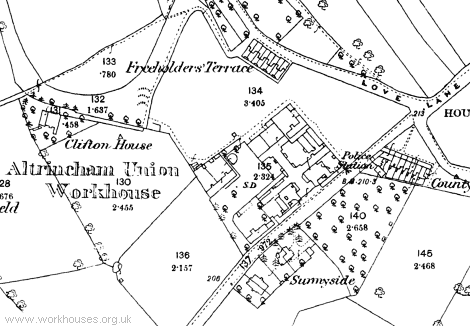
Altrincham Union workhouse site, Knutsford, 1889.
The workhouse was substantially enlarged in 1892-04 with the addition of a new chapel and dining-hall, kitchens, laundry and stores. New union offices were erected at the corner of Stanley Road and Bexton Road. The new layout is shown on the 1909 map by which time the Altrincham Union had been renamed Bucklow Union.
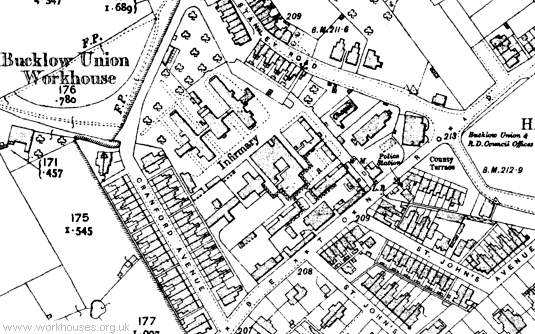
Altrincham Union workhouse site, Knutsford, 1909.
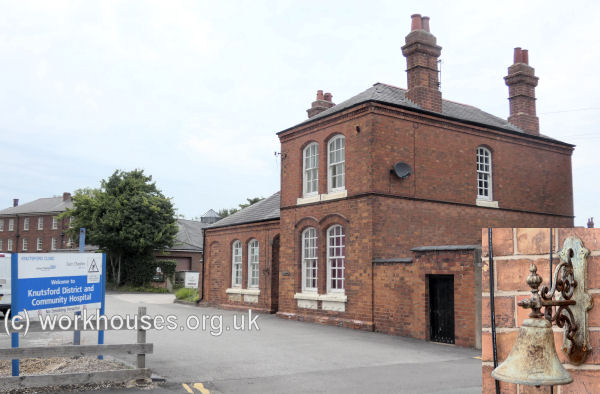
Altrincham workhouse entrance lodge and bell, 2020.
© Peter Higginbotham
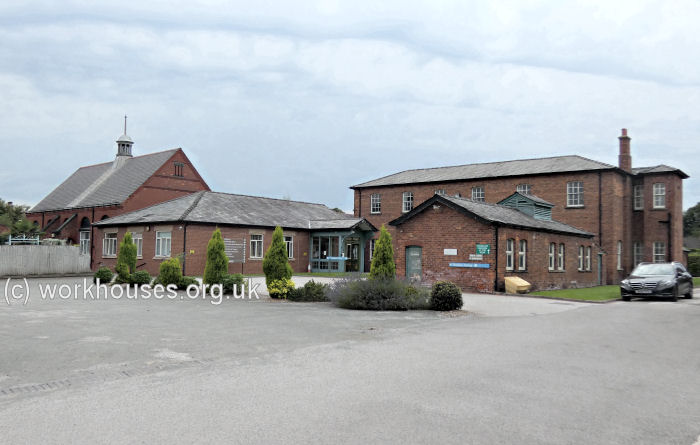
Altrincham general view from the south-east, 2001.
© Peter Higginbotham
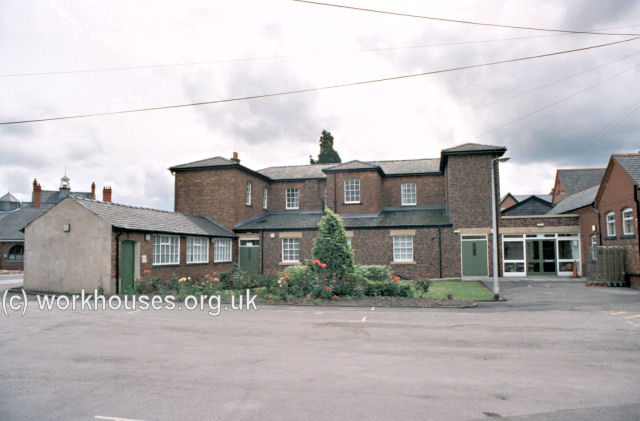
Altrincham ward block from the north-west, 2001.
© Peter Higginbotham
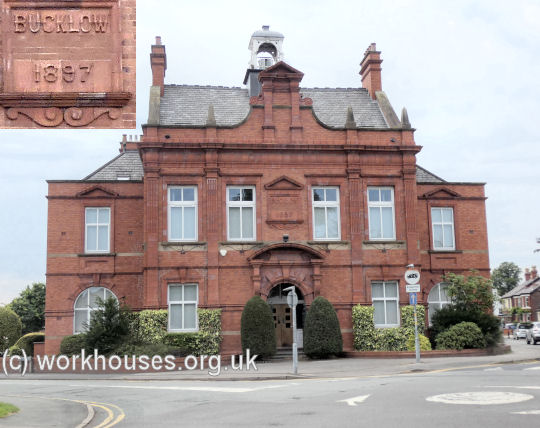
Altrincham workhouse new union offices, 2020.
© Peter Higginbotham
The institution was used as military hospital during the First World War. After 1930, the workhouse was taken over by Cheshire County Council and renamed Bucklow Institution. It subsequently became Cranford Lodge Hospital.
Scattered Home
In the early 1900s, the union established scattered homes for housing its pauper children at Mobberley Road, Knutsford, and at 'Kilrie' on Northwich Road, Knutsford. There was also a receiving home for new admissions at Clifton House on Cranford Avenue, Knutsford.
Staff
Inmates
Records
Note: many repositories impose a closure period of up to 100 years for records identifying individuals. Before travelling a long distance, always check that the records you want to consult will be available.
- Cheshire Archives and Local Studies, Cheshire Record Office, Duke Street, Chester, Cheshire CH1 1RL. Holdings include Guardians' minutes (1844-48, 1865-74, 1877-86, 1888-1928); Indexed register of inmates (1908-40); Deaths (1898-1940); Register of orphans boarded-out (1869-1923); etc.
Bibliography
- Hitchcock, T.V. (1985) The English workhouse: a study in institutional poor relief in selected counties. l695-l750. (DPhil thesis. University of Oxford.)
- Ingham, Alfred (1897) Altrincham and Bowdon: with Historical Reminiscences of Ashton-on-Mersey, Sale, and Surrounding Townships
Links
Unless otherwise indicated, this page () is copyright Peter Higginbotham. Contents may not be reproduced without permission.


